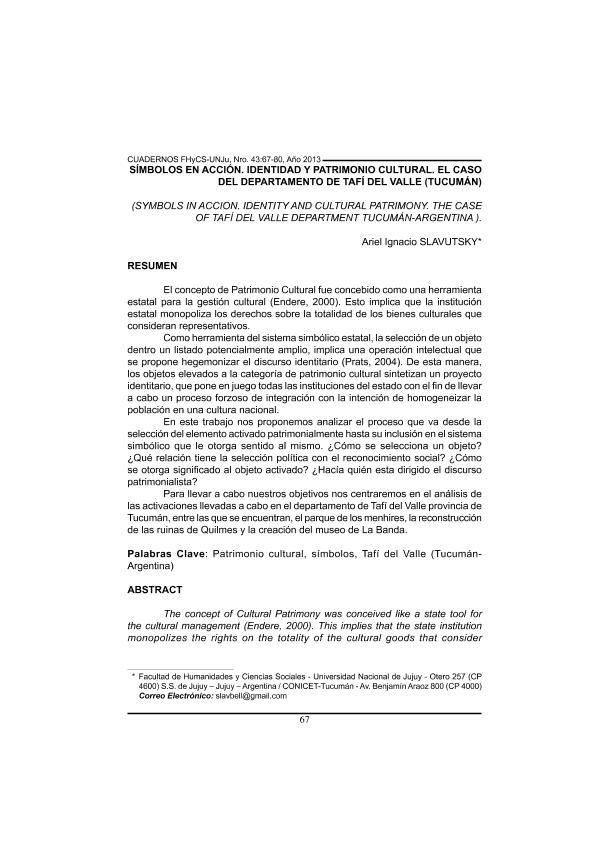Artículo
El concepto de Patrimonio Cultural fue concebido como una herramienta estatal para la gestión cultural (Endere, 2000). Esto implica que la institución estatal monopoliza los derechos sobre la totalidad de los bienes culturales que consideran representativos. Como herramienta del sistema simbólico estatal, la selección de un objeto dentro un listado potencialmente amplio, implica una operación intelectual que se propone hegemonizar el discurso identitario (Prats, 2004). De esta manera, los objetos elevados a la categoría de patrimonio cultural sintetizan un proyecto identitario, que pone en juego todas las instituciones del estado con el fin de llevar a cabo un proceso forzoso de integración con la intención de homogeneizar la población en una cultura nacional. En este trabajo nos proponemos analizar el proceso que va desde la selección del elemento activado patrimonialmente hasta su inclusión en el sistema simbólico que le otorga sentido al mismo. ¿Cómo se selecciona un objeto? ¿Qué relación tiene la selección política con el reconocimiento social? ¿Cómo se otorga significado al objeto activado? ¿Hacía quién esta dirigido el discurso patrimonialista? Para llevar a cabo nuestros objetivos nos centraremos en el análisis de las activaciones llevadas a cabo en el departamento de Tafí del Valle provincia de Tucumán, entre las que se encuentran, el parque de los menhires, la reconstrucción de las ruinas de Quilmes y la creación del museo de La Banda. The concept of Cultural Patrimony was conceived like a state to ol for the cultural management (Endere, 2000). This implies that the state institution monopolizes the rights on the totality of the cultural goods that consider representative. Like tool of the state symbolic system, the selection of an object inside a potentially ample listing, implies an intellectual operation that it sets out to hegemonizar the identitario speech (Prats, 2004). This way, the objects elevated to the category of cultural patrimony synthesize a identitario project, that puts into play all the institutions of the state with the purpose of carrying out an unavoidable process of in tegration with the intention to homogenize the population in a national culture. In this work we set out to analyze the process that goes patrimonially from the selection of the element activated to its inclusion in the symbolic system that grants sense. How selects an object? What relation has the political selection with the social recognition? How grants meaning to the activated object? For whom this directed the patrimonialista speech? In order to carry out our objectives we will be centered in the analysis of the carried out activations in the department of Tafí of the Valley province of Tucumán, between which they are, the park of menhires, the reconstruction of the ruins of Quilmes and the creation of the museum of the Band.
Símbolos en acción. Identidad y patrimonio cultural. El caso del departamento de Tafí del Valle (Tucumán)
Título:
Symbols in accion. Identity and cultural patrimony. The case of Tafí del Valle department Tucumán-Argentina
Fecha de publicación:
06/2013
Editorial:
Universidad Nacional de Jujuy. Facultad de Humanidades y Ciencias Sociales
Revista:
Cuadernos de la Facultad de Humanidades y Ciencias Sociales
ISSN:
0327-1471
Idioma:
Español
Tipo de recurso:
Artículo publicado
Clasificación temática:
Resumen
Palabras clave:
Patrimonio Cultural
,
Símbolos
,
Tafí del Valle (Tucumán)
,
Dictadura Militar
Archivos asociados
Licencia
Identificadores
Colecciones
Articulos(CCT - NOA SUR)
Articulos de CTRO.CIENTIFICO TECNOL.CONICET - NOA SUR
Articulos de CTRO.CIENTIFICO TECNOL.CONICET - NOA SUR
Citación
Slavutsky, Ariel Ignacio; Símbolos en acción. Identidad y patrimonio cultural. El caso del departamento de Tafí del Valle (Tucumán); Universidad Nacional de Jujuy. Facultad de Humanidades y Ciencias Sociales; Cuadernos de la Facultad de Humanidades y Ciencias Sociales; 43; 6-2013; 67-80
Compartir




